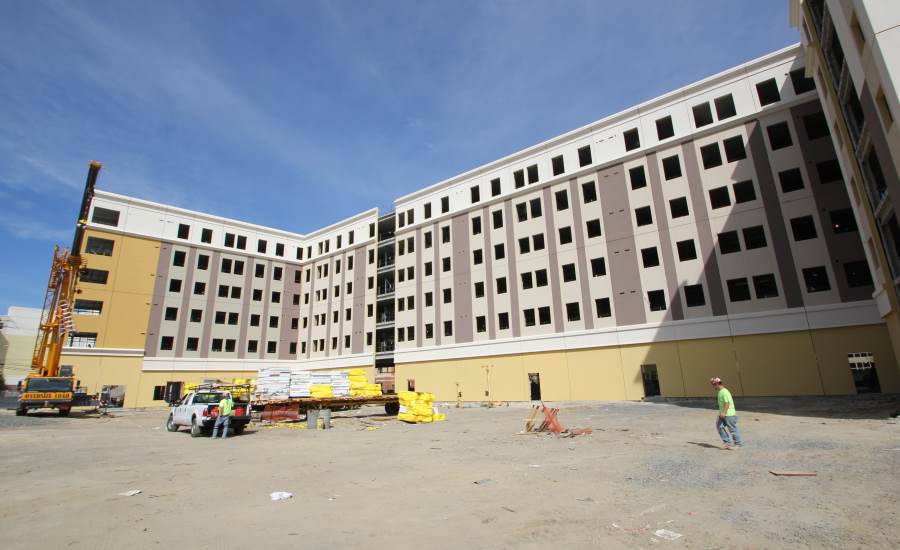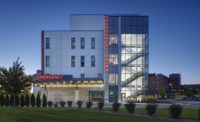The Benefits of Prefab Construction in the Wake of COVID-19

With COVID-19 ravaging the country, the construction industry has been left with a new minefield of problems. While jobsite shut-downs have mostly abated, the construction sector is now left with the struggles of social distancing, the wearing of personal protective equipment to inhibit virus transmission, and the host of scheduling issues that come along with the realities of today’s jobsite.
Enter prefabricated construction, where components of a building are assembled in a factory off-site and transported to the jobsite where the structure is located. While installation speed, cost savings and the quality that goes along with producing components in a controlled environment have always been the prefab construction industry’s claim to fame, current jobsite restrictions paint the benefits in a new light.
With implementation of prefabricated exterior wall panels, multiple trades—potentially handling the cladding, air barrier, sheathing and framing—are not necessitated on jobsite. This greatly reduces the complexities of both labour and material congestion.
Think about the elevators or buck hoists that many workers ride together in the morning in order to get to the proper floor that they need to work on that day. You’re reducing the time and congestion of people waiting to start their work, versus if they come to a panel plant where they can start working in a very safe manner once they arrive. In many cases, parking is scarce on job-sites so the more you take various parts and pieces of the construction process off-site, parking concerns and needed space is reduced in addition to the amount of workers using portable washrooms. Social distancing is so much easier to manage within a climate-controlled panel plant. The list goes on if you just think about it.
Jason Anderson, Vice President of Tempe, Arizona-based, Kapture Prefab, a StoPanel Technology Affiliate, points out the scheduling benefits. The simplicities of scheduling a construction job using prefab components means the only real challenge is crane time, which is typically done during off hours in the afternoon, says Anderson.
“Owners are concerned that COVID is going to rapidly spread through their jobsite, and therefore there’s not enough manpower to give them schedule assurance,” says Anderson. “What I would say with prefab is that there’s schedule certainly. Because when you’re talking about needing a crew of six guys to install an exterior prefab skin versus 60 guys doing it traditionally, I’m fairly certain that in my company or anyone else that participates in prefab at this level can find six guys within their companies that employ hundreds of people.”
Waste reduction measures are another example where prefabricated construction has a clear benefit. Waste with a prefabricated panel is typically packaging only, saving the congestion of materials stored on-site, as well as the need for additional cleaning work and waste sorting that typically is associated with traditional construction. Scaffolding is also reduced or eliminated.
Safety is also a major factor in the benefits of prefab construction. Risks due to outdoor temperature extremes and other inclement weather are all but removed. Along with reduced staff, the reduction in equipment consequently minimizes the many surface contact points that would be introduced with traditional construction. This leaves less monitoring required by site managers.
Chad Stephens, principal at Southern Wall Systems, a StoPanel Technology Affiliate and an EIFS and stucco contracting company with locations in Atlanta and Nashville, stresses that safety is one of his company’s core principles, a clear benefit to working with prefab.
“Prior to the COVID scenario, we were really excited about prefab because it allows us to minimize the actual manpower on site, which is tremendously helpful when it comes to safety issues. Couple that with not having to have this aggressive access, being suspended 150 feet into the air, and working in those conditions, between wind and weather and that sort of thing, even with the best safety measures that are out there, there are still risky scenarios. Having those scenarios in place for extended periods of time, for months and months, it just opens the window for something bad to happen.
“With prefabrication and StoPanel, we’ve really drastically reduced that. A typical project for us, prior to prefabrication, we were probably running anywhere from 30 to 40 men outside for up to 12 to 18 months, which is somewhat standard. With prefab, we’re running probably five to six-man crews, and they’re all inside for two months. So, just that factor alone allows us to drastically reduce our exposure to risky scenarios.”
Potential for a second wave of COVID-19 bringing further lock-down measures in place is a fear shared among many in the building design and construction sector. In the state of Michigan for example, construction was shut down for several weeks, with the exception of cases in specific sectors.
StoPanel Technology affiliate, Bouma Prefab based in Grand Rapids, Michigan president Andrew Rener felt first-hand the sting of construction site shutdowns.
“Every project, save a few medical related projects or food-related projects were all considered non-essential, and therefore nobody was allowed to work on them,” says Rener. “So now you have owners who are going to get delayed delivery and have extended financing costs. Some are looking to prefab; some are looking at other means. But I think if there’s any potential for a second wave or any future issues like this, I think you’ll have owners that are looking for certainty of outcome and schedule, and efficient enclosure of the building – there’s a lot more desirability [with prefab]. I think with a lot of owners, and we’ve been owners before, there’s been a paradigm shift.”
Looking for a reprint of this article?
From high-res PDFs to custom plaques, order your copy today!






